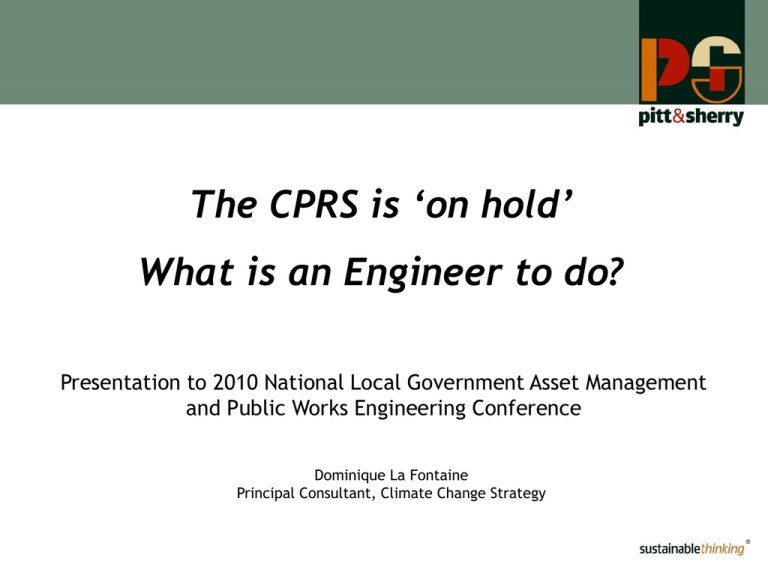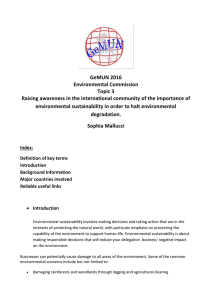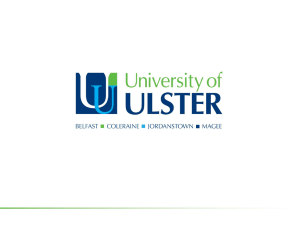'on hold' What is an Engineer to do?
advertisement

The CPRS is ‘on hold’ What is an Engineer to do? Presentation to 2010 National Local Government Asset Management and Public Works Engineering Conference Dominique La Fontaine Principal Consultant, Climate Change Strategy ® • pitt&sherry • Snapshot of climate change policy & regulation in Australia • Post Copenhagen snapshot • What asset managers and engineers do ® Who does pitt&sherry service? pitt&sherry is a leading Australian professional services company, founded in 1963 and currently employing approximately 180 people in five offices located around Australia Industrial infrastructure Land Transport Community infrastructure Climate Change and Sustainability ® Australia’s Emission Reduction Commitment ® Energy Efficiency Opportunities Program • Introduced in July 2006 to improve identification, evaluation and public reporting of energy efficiency opportunities by large energy using businesses. • Corporations that use more than 0.5 pj/annum (equivalent to a $1.5 million gas bill, $11million diesel bill). • Must undertake rigorous assessment of EE opportunities with up to 4 year payback period. ® Prime Ministers Task group on Energy Efficiency • Energy efficiency is a key plank of the Rudd Government's climate change agenda • Nine industry and non-government sector experts • Reduce emissions and move Australia to a low-carbon economy. • The role of the Task Group is to: – report on the most economically and environmentally effective mechanisms to deliver major improvements in Australia's energy efficiency; and – consult with industry and community groups and seek their input on policy ideas and mechanisms to drive these changes. ® Renewable Energy Target • Expand renewable energy in Australia four fold • $20 billion on investment, most of this in large scale infrastructure • REC penalty price $65MWhr • Recent modifications to enhance operation of the market ® National GHG and Energy Reporting System • Single, national reporting framework for reporting of energy consumption, production and GHG emissions • If an individual facility meets any one of the following: – greenhouse gas emissions of 25 kilotonnes of CO2-e (scope 1 and scope2) – energy production of 100 terajoules – energy consumption of 100 terajoules • • • Higher thresholds apply for a corporate group Non compliance is penalised, CEOs personally liable Contractor and subcontractors that undertake activities associated with a facility will be asked to report emissions and energy produced and consumed ® The Carbon Pollution Reduction Scheme on hold for now Cap emissions allowed per annum to establish a ‘market’ for Australian emission units (AEU). Market will be sheltered by capping AEU price at $10 for the first 12 months then $40/tonne to increase 5% real per annum from 2012-13 until 2015-16. The Government will issue, mostly via monthly auction, an equivalent quantity of AEUs. One quarter will allocated free of charge. Cover 75% of Australia’s emissions through mandatory obligations for approximately 1000 major polluting companies (a small percentage of Australia’s 7.6million businesses) ® The Carbon Pollution Reduction Scheme on hold for now Liable entities must obtain and submit one AEU for each tonne of C02-e they emit. Costs will be passed downstream to other business and consumers through increased prices. Business can bank and borrow AEUs indefinitely. Any individual or business can hold and trade an AEU. Only AEUs and eligible international units accepted for voluntary surrender ® CPRS Transitional Assistance • Entities that are ‘trade exposed’ and highly emissions intensive will be provided with assistance. • 95% and 65% free AEUs depending on emissions and trade exposure. • Initial assistance rate will decrease by 1.3%/annum for 10 years • $3 billion of EITE assistance • Electricity Industry Assistance • Climate Change Action Fund ® May 2010 budget $5.1 billion Clean Energy Initiative includes: May 2010 budget announcement Renewable Energy Future Fund $652.5 million over four years • development and deployment of large and small scale renewable energy projects, for example further investments in geothermal, solar and wave energy; and • take-up of industrial, commercial and residential energy efficiency, helping Australian businesses and households reduce their energy consumption. ® Coalition policy … NGER liable business can reduce their emissions below their individual baseline (‘historic average’) will be able to offer this CO2 abatement for sale to the government in tender process Expert panel to assess tenders, successful tenders will 1. reduce CO2 emissions; 2. deliver additional practical environmental benefits; 3. not result in price increases to consumers; 4. protect Australian jobs; and 5. not otherwise proceed without Fund assistance. Small businesses and other entities not covered by NGERS can ‘opt-in’ Businesses with an emissions level above ‘business as usual’ levels will incur financial penalty. Value of penalties - sliding scale at levels commensurate with the size of the business and the extent to which they exceed their ‘business as usual’ levels. Penalties will not apply to new entrants or business expansion at ‘best practice.’ Value of the penalties will be set in consultation with industry. ® Coalition Policy? Target - 5% by 2020 of 1990 levels Establish Emission Reduction Fund to pay for abatement through soil carbon and other direct measures ® Industry Measures AGIC – Sustainability Rating Tool Engineers Australia Sustainability Charter • Objectives for sustainable development • Realisation of aspirational objectives Roads Australia – Sustainability Chapter Draft Sustainability Policy • agree on a common set of national sustainability performance indicators • identify opportunities to reduce both greenhouse gas emissions and unsustainable use of other resources such as water and pavement materials • address the impacts of a changing climate on performance of our roads ® Carbon Disclosure Project • Independent not-for-profit organisation • 2500 companies in 60 countries measure and disclose their greenhouse gas emissions and climate change strategies through CDP, to set reduction targets and make performance improvements. • Responding suppliers include BASF, OneSteel, Intel Corporation, Acer, Foxcom Technology, Siemans, Citroen, Pepsi, Cadbury’s, NEC and Phillips • “Between 40-60% of organisations’ total greenhouse gas emissions are recognised as residing outside their direct control and are found within the supply chain through activities such as processing, packaging and transportation. It is therefore critical that senior management understand climate change risks within their supply chain and how suppliers are managing those risks.” Carbon Disclosure project ® Copenhagen Accord • Raised climate change to the highest level of government. • Political consensus on the long-term, global response to climate change • Deep cuts in global emissions are required to stabilize greenhouse gas concentration to prevent dangerous anthropogenic interference with the climate system, • Increase in global temperature should be kept to below 2 degrees Celsius • Cooperate in achieving the peaking of global and national emissions as soon as possible, recognizing that the time frame for peaking will be longer in developing countries • Pursue various approaches, including opportunities to use markets, to enhance the cost-effectiveness of and to promote mitigation actions • Establish a comprehensive adaptation programme including international support • $100 billion of funding for investment in low-carbon economic growth in the developing nations to assist their transition ® Copenhagen Accord Commitments so far equate to 80% per cent of global emissions from energy use • 41 industrialised countries’ economywide targets • 35 developing countries’ nationally appropriate mitigation actions ® ® ® ® Grocon’s Pixel Carlton Brewery ® Infrastructure and climate adaptation Strategies to understand and manage the risk to asset performance and value posed by the projected physical impacts of climate change • • • • • Lower rainfall More frequent intense storm activity Higher temperatures Sea level rise Inundation How are these risks being analysed and risk management strategies being disclosed to your stakeholders? ® Don’t be sidetracked! • Internationally – business is being proactive, governments are pressing ahead with regulation • Economies are understanding carbon competitiveness • Efforts to reach a binding international agreement continue unabated • Measurement and reporting obligations are well entrenched for Australia’s higher emitters and energy consumers • Energy efficiency regulation is being enhanced ® Don’t be sidetracked! • Carbon pricing (tax or market based) will increase the cost of emissions intensive products and services • Opportunities exist for companies that embrace the challenge • Energy costs increasing – regulatory uncertainty clean energy initiatives, lack of investment, demand growth • Community awareness about climate change and sustainability is driving consumer and shareholder expectations, client demand, corporate image concerns, supply chain issues • Climate change is a real risk that must be managed ® Questions for asset managers and engineers • • • • • • Are you familiar with your organisation’s sustainability and climate change objectives – are they measurable and relevant to your projects? Do you know how to operationalise these objectives for the assets you manage? Are you measuring the carbon footprints of your asset construction and operation? Do you use a decision making framework that benchmarks against sustainability indicators in addition to performance, capex and opex? How will the evolving climate change regulatory framework affect your business and your industry What funding opportunities exist to help with sustainable investment? ® Questions for asset managers and engineers • • • • • • How do you produce tenders that incentivise sustainable resource use, low carbon and clean energy. How do you evaluate and reward these proposals? How do you submit tenders that leverage these aspects? How will a carbon price and higher energy prices impact directly and indirectly through the supply chain? Do you know enough about low carbon and energy alternatives – their availability, performance, cost? How are competitors, contemporaries and clients addressing sustainability and climate change challenges? How do you communicate positive action to stakeholders? Remember being proactive makes good business sense! ® Dominique La Fontaine Principal Consultant, Climate Change Strategy dlafontaine@pittsh.com.au www.pittsh.com.au ®







